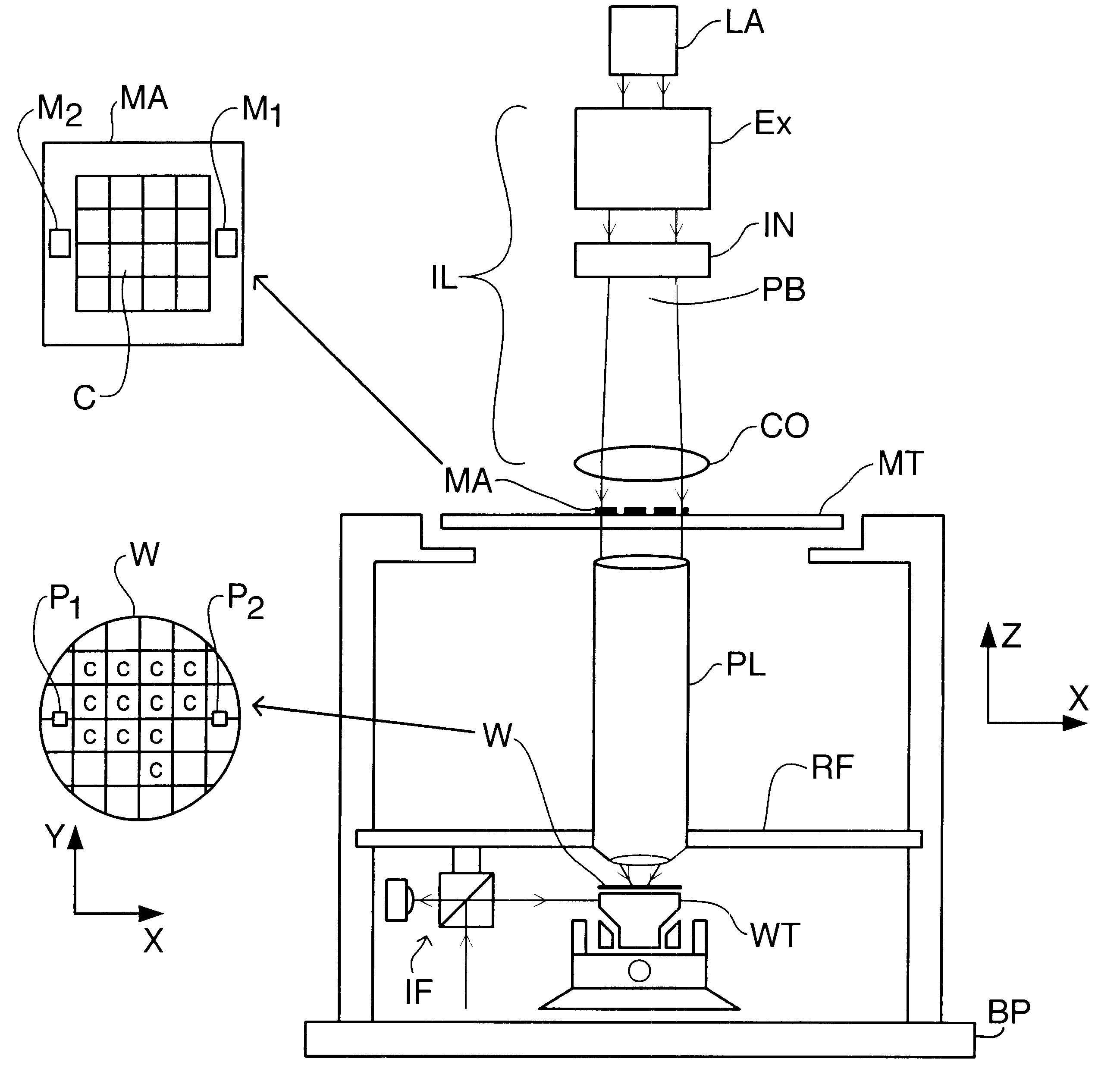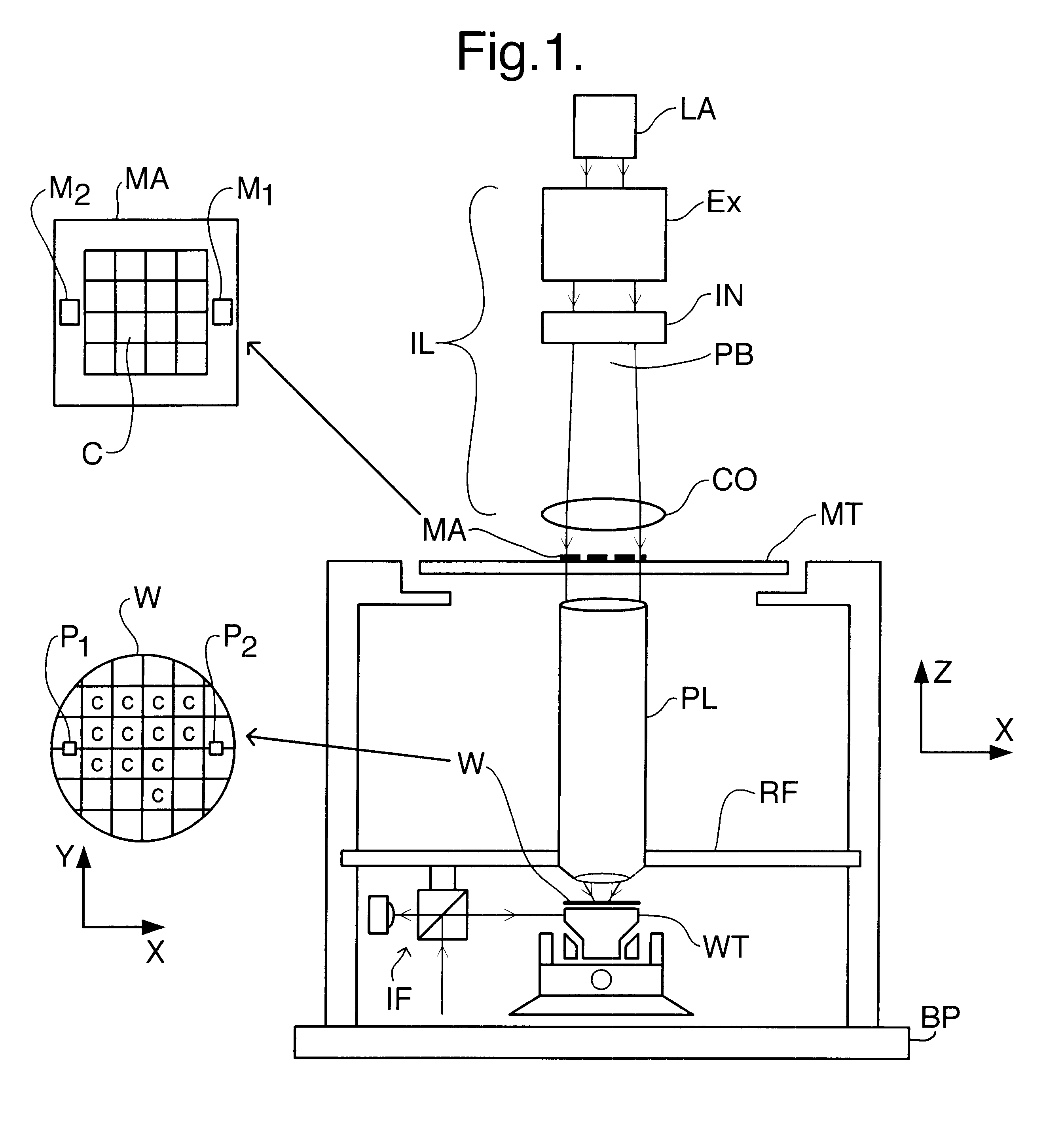Balanced positioning system for use in lithographic apparatus
- Summary
- Abstract
- Description
- Claims
- Application Information
AI Technical Summary
Benefits of technology
Problems solved by technology
Method used
Image
Examples
embodiment 1
FIG. 1 schematically depicts a lithographic projection apparatus according to the invention. The apparatus comprises:
a radiation system LA, IL for supplying a projection beam PB of radiation (e.g. UV or EUV radiation, x-rays, electrons or ions);
a first object table (mask table) MT provided with a mask holder for holding a mask MA (e.g. a reticle), and connected to first positioning means for accurately positioning the mask with respect to item PL;
a second object table (substrate table) WT provided with a substrate holder for holding a substrate W (e.g. a resist-coated silicon wafer), and connected to second positioning means for accurately positioning the substrate with respect to item PL;
a projection system ("lens") PL (e.g. a refractive or catadioptric system, a mirror group or an array of field deflectors) for imaging an irradiated portion of the mask MA onto a target portion C of the substrate W.
As here depicted, the apparatus is of a transmissive type (i.e. has a transmissive m...
embodiment 2
The substrate stage, comprising substrate table WT, of a second embodiment of the invention, which may be the same as the first embodiment save as described below, is shown in FIG. 12.
In the second embodiment, the balance mass 406 takes the form of an open box with a flat interior base 407, forming a guide surface for the wafer table WT, and upstanding side walls 408 serving to raise the center of gravity of the balance mass 406. The substrate table WT includes a fine positioning mechanism 417 operating in 6 degrees of freedom for the substrate W and a so-called air-foot forming a substantially frictionless bearing allowing the substrate table WT to be moved over the guide surface 407.
Movement of the substrate table WT is effected by the coarse positioning mechanism. This includes X-beam 415 relative to which the substrate table WT is driven by an X-driver (not shown) which has at its ends sliders 411 which include the translators of Y-direction linear motors to drive the X-beam, an...
embodiment 3
FIG. 13 depicts the substrate stage, comprising substrate table WT, of a third embodiment of the invention, which may be the same as the first or second embodiments described above.
In the third embodiment, the balance mass is divided into two parts 506, 507. The first balance mass part 506 comprises a rectangular frame surrounding the substrate table WT. Opposite sides of the first balance mass part 506 have mounted thereon the stator, e.g. the magnet track, of the Y-direction linear motors. The translators, e.g. coils, of the Y-direction linear motors, are mounted in sliders 511 at the ends of X-beam 515. The X-beam includes the stator of X-linear motor and the translator is mounted to the substrate table WT. Y- and R.sub.z -reaction forces from the Y linear motor, which forms the coarse positioning mechanism together with the X-linear motor, arc transmitted directly to the first balance mass part 506 and the X-reaction forces are transmitted via thrust bearings (not shown). To abs...
PUM
 Login to View More
Login to View More Abstract
Description
Claims
Application Information
 Login to View More
Login to View More - R&D
- Intellectual Property
- Life Sciences
- Materials
- Tech Scout
- Unparalleled Data Quality
- Higher Quality Content
- 60% Fewer Hallucinations
Browse by: Latest US Patents, China's latest patents, Technical Efficacy Thesaurus, Application Domain, Technology Topic, Popular Technical Reports.
© 2025 PatSnap. All rights reserved.Legal|Privacy policy|Modern Slavery Act Transparency Statement|Sitemap|About US| Contact US: help@patsnap.com



